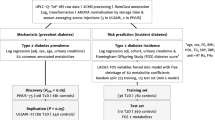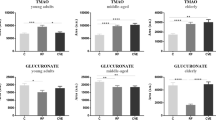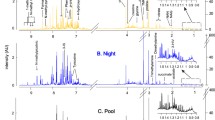Abstract
Recently research provides evidence that blood metabolite profiles predicted type 2 diabetes. We aimed to assess the relation of urine metabolites measured via nuclear magnetic resonance spectroscopy with incident type 2 diabetes in a sample of 1353 men and 1356 women. Within 5 years, 87 men and 50 women developed diabetes. Five and 16 urine metabolites were associated with incident diabetes in men and women, respectively. Only three of these metabolites (glucose, lactate and glycine) were found in both sexes. In women, e.g. acetate, carnitine, N,N-dimethylglycine, trigonelline, 3-hydroxyisovalerate, alanine, formate, glycolate, trimethylamine N-oxide and tau-methylhistidine were positively related with diabetes. Receiver operating characteristic (ROC) analysis revealed that compared with a standard model, a model additionally adjusted for urine glucose, trigonelline and trimethylamine N-oxide levels showed a better discrimination between incident diabetes cases and non-cases in women (AUC = 0.874 and 0.903, p = 0.019). In men, valine and 4-hydroxyphenylacetate were found as markers of diabetes. However, ROC analysis did not reveal any improvement in discrimination based on urine metabolites. In conclusion, we confirmed the potential of metabolomics to assess the risk of type 2 diabetes and detected pronounced sex differences. Moreover, we demonstrated the practicability of spot urine samples as potential non-invasive diabetes screening approach.



Similar content being viewed by others
References
Ahonen, T., Vanhala, M., Kautiainen, H., Kumpusalo, E., & Saltevo, J. (2012). Sex differences in the association of adiponectin and low-grade inflammation with changes in the body mass index from youth to middle age. Gender Medicine, 9(1), 1–8. doi:10.1016/j.genm.2012.01.002.
Bain, M. A., Faull, R., Fornasini, G., Milne, R. W., & Evans, A. M. (2006). Accumulation of trimethylamine and trimethylamine-N-oxide in end-stage renal disease patients undergoing haemodialysis. Nephrology, Dialysis, Transplantation, 21(5), 1300–1304.
Barrett-Connor, E. L., Cohn, B. A., Wingard, D. L., & Edelstein, S. L. (1991). Why is diabetes mellitus a stronger risk factor for fatal ischemic heart disease in women than in men? the rancho bernardo study. JAMA, 265(5), 627–631.
Bastard, J. P., Maachi, M., Lagathu, C., Kim, M. J., Caron, M., Vidal, H., et al. (2006). Recent advances in the relationship between obesity, inflammation, and insulin resistance. European Cytokine Network, 17(1), 4–12.
Bloomgarden, Z. T. (2010). World Congress on the insulin resistance syndrome, 2009: Cellular mechanisms of insulin resistance. Diabetes Care, 33(8), e103–e108. doi:10.2337/dc10-zb08.
Camhi, S. M., Bray, G. A., Bouchard, C., Greenway, F. L., Johnson, W. D., Newton, R. L., et al. (2011). The relationship of waist circumference and BMI to visceral, subcutaneous, and total body fat: Sex and race differences. Obesity (Silver Spring), 19(2), 402–408. doi:10.1038/oby.2010.248.
Clausen, J. O., Borch-Johnsen, K., Ibsen, H., Bergman, R. N., Hougaard, P., Winther, K., et al. (1996). Insulin sensitivity index, acute insulin response, and glucose effectiveness in a population-based sample of 380 young healthy Caucasians. Analysis of the impact of gender, body fat, physical fitness, and life-style factors. Journal of Clinical Investigation, 98(5), 1195–1209. doi:10.1172/JCI118903.
Coppack, S. W. (2001). Pro-inflammatory cytokines and adipose tissue. Proceedings of the Nutrition Society, 60(3), 349–356.
Dellow, W. J., Chambers, S. T., Barrell, G. K., Lever, M., & Robson, R. A. (2001). Glycine betaine excretion is not directly linked to plasma glucose concentrations in hyperglycaemia. Diabetes Research and Clinical Practice, 52(3), 165–169.
Dellow, W. J., Chambers, S. T., Lever, M., Lunt, H., & Robson, R. A. (1999). Elevated glycine betaine excretion in diabetes mellitus patients is associated with proximal tubular dysfunction and hyperglycemia. Diabetes Research and Clinical Practice, 43(2), 91–99.
Doi, Y., Kiyohara, Y., Kubo, M., Ninomiya, T., Wakugawa, Y., Yonemoto, K., et al. (2005). Elevated C-reactive protein is a predictor of the development of diabetes in a general Japanese population: The Hisayama Study. Diabetes Care, 28(10), 2497–2500.
Ferrannini, E., Natali, A., Bell, P., Cavallo-Perin, P., Lalic, N., & Mingrone, G. (1997). Insulin resistance and hypersecretion in obesity. European Group for the Study of Insulin Resistance (EGIR). Journal of Clinical Investigation, 100(5), 1166–1173. doi:10.1172/JCI119628.
Ferris, W. F., & Crowther, N. J. (2011). Once fat was fat and that was that: Our changing perspectives on adipose tissue. Cardiovascular Journal of Africa, 22(3), 147–154.
Floegel, A., Stefan, N., Yu, Z., Muhlenbruch, K., Drogan, D., Joost, H. G., et al. (2013). Identification of serum metabolites associated with risk of type 2 diabetes using a targeted metabolomic approach. Diabetes, 62(2), 639–648. doi:10.2337/db12-0495.
Friedrich, N. (2012). Metabolomics in Diabetes Research. Journal of Endocrinology, 215(1), 29–42. doi:10.1530/JOE-12-0120.
Geer, E. B., & Shen, W. (2009). Gender differences in insulin resistance, body composition, and energy balance. Gender Medicine, 6(Suppl 1), 60–75. doi:10.1016/j.genm.2009.02.002.
Han, T. S., Sattar, N., Williams, K., Gonzalez-Villalpando, C., Lean, M. E., & Haffner, S. M. (2002). Prospective study of C-reactive protein in relation to the development of diabetes and metabolic syndrome in the Mexico City Diabetes Study. Diabetes Care, 25(11), 2016–2021.
Kaur, P., Rizk, N., Ibrahim, S., Luo, Y., Younes, N., Perry, B., et al. (2013). Quantitative metabolomic and lipidomic profiling reveals aberrant amino acid metabolism in type 2 diabetes. Molecular BioSystems, 9(2), 307–317. doi:10.1039/c2mb25384d.
Kawamoto, R., Tabara, Y., Kohara, K., Miki, T., Kusunoki, T., Takayama, S., et al. (2011). Association between fasting plasma glucose and high-sensitivity C-reactive protein: Gender differences in a Japanese community-dwelling population. Cardiovasc Diabetol, 10, 51. doi:10.1186/1475-2840-10-51.
Keil, U., Stieber, J., Doring, A., Chambless, L., Hartel, U., Filipiak, B., et al. (1988). The cardiovascular risk factor profile in the study area Augsburg. Results from the first MONICA survey 1984/85. Acta Medica Scandinavica Supplement, 728, 119–128.
Koeth, R. A., Wang, Z., Levison, B. S., Buffa, J. A., Org, E., Sheehy, B. T., et al. (2013). Intestinal microbiota metabolism of L-carnitine, a nutrient in red meat, promotes atherosclerosis. Nature Medicine, 19(5), 576–585. doi:10.1038/nm.3145.
Lipscombe, L. L., & Hux, J. E. (2007). Trends in diabetes prevalence, incidence, and mortality in Ontario, Canada 1995-2005: A population-based study. The Lancet, 369(9563), 750–756. doi:10.1016/S0140-6736(07)60361-4.
McGown, C., Birerdinc, A., & Younossi, Z. M. (2014). Adipose tissue as an endocrine organ. Clinics in Liver Disease, 18(1), 41–58. doi:10.1016/j.cld.2013.09.012.
Messana, I., Forni, F., Ferrari, F., Rossi, C., Giardina, B., & Zuppi, C. (1998). Proton nuclear magnetic resonance spectral profiles of urine in type II diabetic patients. Clinical Chemistry, 44(7), 1529–1534.
Mittelstrass, K., Ried, J. S., Yu, Z., Krumsiek, J., Gieger, C., Prehn, C., et al. (2011). Discovery of sexual dimorphisms in metabolic and genetic biomarkers. PLoS Genetics, 7(8), e1002215. doi:10.1371/journal.pgen.1002215.
Moran, A., Jacobs, D. R, Jr, Steinberger, J., Steffen, L. M., Pankow, J. S., Hong, C. P., et al. (2008). Changes in insulin resistance and cardiovascular risk during adolescence: Establishment of differential risk in males and females. Circulation, 117(18), 2361–2368. doi:10.1161/CIRCULATIONAHA.107.704569.
Nakanishi, S., Yamane, K., Kamei, N., Okubo, M., & Kohno, N. (2003). Elevated C-reactive protein is a risk factor for the development of type 2 diabetes in Japanese Americans. Diabetes Care, 26(10), 2754–2757.
Nuutila, P., Knuuti, M. J., Maki, M., Laine, H., Ruotsalainen, U., Teras, M., et al. (1995). Gender and insulin sensitivity in the heart and in skeletal muscles studies using positron emission tomography. Diabetes, 44(1), 31–36.
Otsuki, M., Kasayama, S., Saito, H., Mukai, M., & Koga, M. (2005). Sex differences of age-dependent changes of insulin sensitivity in Japanese nondiabetic subjects. Diabetes Care, 28(10), 2590–2591.
Perreault, L., Ma, Y., Dagogo-Jack, S., Horton, E., Marrero, D., Crandall, J., et al. (2008). Sex differences in diabetes risk and the effect of intensive lifestyle modification in the Diabetes Prevention Program. Diabetes Care, 31(7), 1416–1421. doi:10.2337/dc07-2390.
Rhee, E. P., & Gerszten, R. E. (2012). Metabolomics and cardiovascular biomarker discovery. Clinical Chemistry, 58(1), 139–147.
Sattar, N. (2013). Gender aspects in type 2 diabetes mellitus and cardiometabolic risk. Best Practice and Research Clinical Endocrinology and Metabolism, 27(4), 501–507. doi:10.1016/j.beem.2013.05.006.
Sesmilo, G., Biller, B. M., Llevadot, J., Hayden, D., Hanson, G., Rifai, N., et al. (2000). Effects of growth hormone administration on inflammatory and other cardiovascular risk markers in men with growth hormone deficiency. A randomized, controlled clinical trial. Annals of Internal Medicine, 133(2), 111–122.
Shaham, O., Wei, R., Wang, T. J., Ricciardi, C., Lewis, G. D., Vasan, R. S., et al. (2008). Metabolic profiling of the human response to a glucose challenge reveals distinct axes of insulin sensitivity. Molecular Systems Biology, 4, 214. doi:10.1038/msb.2008.50.
Sicree, R. A., Zimmet, P. Z., Dunstan, D. W., Cameron, A. J., Welborn, T. A., & Shaw, J. E. (2008). Differences in height explain gender differences in the response to the oral glucose tolerance test- the ausdiab study. Diabetic Medicine, 25(3), 296–302. doi:10.1111/j.1464-5491.2007.02362.x.
Slupsky, C. M., Rankin, K. N., Wagner, J., Fu, H., Chang, D., Weljie, A. M., et al. (2007). Investigations of the effects of gender, diurnal variation, and age in human urinary metabolomic profiles. Analytical Chemistry, 79(18), 6995–7004. doi:10.1021/ac0708588.
Storey, J. D., & Tibshirani, R. (2003). Statistical significance for genomewide studies. Proceedings of the National Academy of Sciences USA, 100(16), 9440–9445. doi:10.1073/pnas.1530509100.
Suhre, K., Meisinger, C., Doring, A., Altmaier, E., Belcredi, P., Gieger, C., et al. (2010). Metabolic footprint of diabetes: A multiplatform metabolomics study in an epidemiological setting. PLoS One, 5(11), e13953. doi:10.1371/journal.pone.0013953.
Tang, W. H., Wang, Z., Levison, B. S., Koeth, R. A., Britt, E. B., Fu, X., et al. (2013a). Intestinal microbial metabolism of phosphatidylcholine and cardiovascular risk. New England Journal of Medicine, 368(17), 1575–1584. doi:10.1056/NEJMoa1109400.
Tang, W. H., Wang, Z., Wu, Y., Fan, Y., Koeth, R. A., & Hazen, S. L. (2013b). Gut flora metabolite trimethylamine N-oxide predicts incident cardiovascular risks in both stable non-diabetics and diabetic subjects. Journal of the American College of Cardiology, 61(10), E1398.
Thorand, B., Baumert, J., Kolb, H., Meisinger, C., Chambless, L., Koenig, W., et al. (2007). Sex differences in the prediction of type 2 diabetes by inflammatory markers: Results from the MONICA/KORA Augsburg case-cohort study, 1984-2002. Diabetes Care, 30(4), 854–860. doi:10.2337/dc06-1693.
van Dijk, A. E., Olthof, M. R., Meeuse, J. C., Seebus, E., Heine, R. J., & van Dam, R. M. (2009). Acute effects of decaffeinated coffee and the major coffee components chlorogenic acid and trigonelline on glucose tolerance. Diabetes Care, 32(6), 1023–1025. doi:10.2337/dc09-0207.
Vannini, P., Marchesini, G., Forlani, G., Angiolini, A., Ciavarella, A., Zoli, M., et al. (1982). Branched-chain amino acids and alanine as indices of the metabolic control in type 1 (insulin-dependent) and type 2 (non-insulin-dependent) diabetic patients. Diabetologia, 22(3), 217–219.
Völzke, H., Alte, D., Schmidt, C. O., Radke, D., Lorbeer, R., Friedrich, N., et al. (2011). Cohort Profile: The Study of Health in Pomerania. International Journal of Epidemiology, 40(2), 294–307. doi:10.1093/ije/dyp394.
Wang, X., Bao, W., Liu, J., Ouyang, Y. Y., Wang, D., Rong, S., et al. (2013a). Inflammatory markers and risk of type 2 diabetes: A systematic review and meta-analysis. Diabetes Care, 36(1), 166–175. doi:10.2337/dc12-0702.
Wang, T. J., Larson, M. G., Vasan, R. S., Cheng, S., Rhee, E. P., McCabe, E., et al. (2011). Metabolite profiles and the risk of developing diabetes. Nature Medicine, 17(4), 448–453. doi:10.1038/nm.2307.
Wang, T. J., Ngo, D., Psychogios, N., Dejam, A., Larson, M. G., Vasan, R. S., et al. (2013b). 2-Aminoadipic acid is a biomarker for diabetes risk. The Journal of clinical investigation, 123(10), 4309–4317. doi:10.1172/JCI64801.
Wang-Sattler, R., Yu, Z., Herder, C., Messias, A. C., Floegel, A., He, Y., et al. (2012). Novel biomarkers for pre-diabetes identified by metabolomics. Molecular Systems Biology, 8, 615. doi:10.1038/msb.2012.43.
Wopereis, S., Rubingh, C. M., van Erk, M. J., Verheij, E. R., van Vliet, T., Cnubben, N. H., et al. (2009). Metabolic profiling of the response to an oral glucose tolerance test detects subtle metabolic changes. PLoS One, 4(2), e4525. doi:10.1371/journal.pone.0004525.
Yin, P., Peter, A., Franken, H., Zhao, X., Neukamm, S. S., Rosenbaum, L., et al. (2013). Preanalytical aspects and sample quality assessment in metabolomics studies of human blood. Clinical Chemistry, 59(5), 833–845. doi:10.1373/clinchem.2012.199257.
Yki-Jarvinen, H. (1984). Sex and insulin sensitivity. Metabolism, 33(11), 1011–1015.
Yoshinari, O., Sato, H., & Igarashi, K. (2009). Anti-diabetic effects of pumpkin and its components, trigonelline and nicotinic acid, on Goto-Kakizaki rats. Bioscience, Biotechnology, and Biochemistry, 73(5), 1033–1041.
Yu, W. M., Kuhara, T., Inoue, Y., Matsumoto, I., Iwasaki, R., & Morimoto, S. (1990). Increased urinary excretion of beta-hydroxyisovaleric acid in ketotic and non-ketotic type II diabetes mellitus. Clinica Chimica Acta, 188(2), 161–168.
Acknowledgments
SHIP is part of the Community Medicine Research net of the University of Greifswald, Germany, which is funded by the Federal Ministry of Education and Research (Grant Nos. 01ZZ9603, 01ZZ0103, and 01ZZ0403), the Ministry of Cultural Affairs as well as the Social Ministry of the Federal State of Mecklenburg-West Pomerania. Preparation and NMR measurement was supported by Bruker BioSpin GmbH Rheinstetten, Germany. This work is also part of the research project Greifswald Approach to Individualized Medicine (GANI_MED). The GANI_MED consortium is funded by the Federal Ministry of Education and Research and the Ministry of Cultural Affairs of the Federal State of Mecklenburg—West Pomerania (03IS2061A).
Conflict of interest
The authors declare that they have no conflict of interest.
Compliance with ethical requirements
All procedures performed in studies involving human participants were in accordance with the ethical standards of the institutional and/or national research committee and with the 1964 Helsinki declaration and its later amendments or comparable ethical standards.
Informed consent
Informed consent was obtained from all individual participants included in the study.
Author information
Authors and Affiliations
Corresponding author
Electronic supplementary material
Below is the link to the electronic supplementary material.
Rights and permissions
About this article
Cite this article
Friedrich, N., Budde, K., Suhre, K. et al. Sex differences in urine metabolites related with risk of diabetes using NMR spectroscopy: results of the study of health in pomerania. Metabolomics 11, 1405–1415 (2015). https://doi.org/10.1007/s11306-015-0795-6
Received:
Accepted:
Published:
Issue Date:
DOI: https://doi.org/10.1007/s11306-015-0795-6




